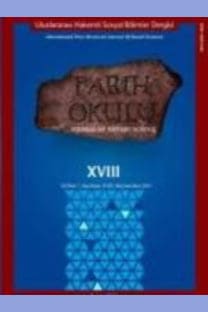ÇEVİRMEN BİR SİMÜLATÖR MÜ YOKSA "GERÇEK" BİR YAZAR MI? ÇEVİRMENİN ÇEVİRİ SÜRECİNDEKİ KONUMUNUN VENUTİCİ BAKIŞ AÇISINDAN BİR ANALİZİ
Yerlileştirme ve yabancılaştırma çeviri stratejilerine değinen ilk çeviribilimci Schleiermacher'in görüşlerini ve Romantik akımın çevirinin yabancılaştırılarak aktarılması gerektiğine dair düşünceyi yirminci yüzyıldaki koşullara göre yeniden ele alan Venuti bunları farklı bir potada eriterek çevirinin görünürlüğü ve görünmezliği kavramlarını ortaya atmıştır. Venutiye göre çevirmen kaynak metni erek kültüre adapte ederek aktardığında, bir diğer ifade ile yerlileştirme çeviri stratejisine başvurduğunda görünmez olmayı ancak yabancılaştırma çeviri stratejisine başvurduğunda görünür olmayı tercih etmektedir. Bir diğer ifade ile çevirmenin görünmezliği çevirinin orijinal dilinde yazılmış gibi okunması, görünürlüğü ise çevirinin erek kitle tarafından çeviri olduğu bilinerek okunulması anlamına gelmektedir. Bu çalışmada, çevirmenin görünür olmayı tercih ederek bir simulatör rolünde çeviri yapmasının mı yoksa görünmez olmayı tercih ederek gerçek bir yazar gibi çeviri yapmasının mı etik olduğu tartışılmış ve çeviribilimsel açıdan en somut araştırma nesnesinin çeviri ürünü olduğu düşünüldüğünde, çevirinin bir bilim dalı olarak olgunlaşmayı sürdürebilmesi ve çeviri metnin de en az kaynak metin kadar orijinal bir metin olduğunu vurgulamak için çevirinin çeviri gibi okunması gerektiği sonucuna varılmıştır. Çalışmada betimleyici yaklaşım uygulanmıştır
Translator as a Simulator or A "Real" Author: An Analysis of Translator's Position in The Translation Process from a Venutian Perspective
Discussing the views put forward by the first translation scholar Schleiermacher on domestication and foreignization translation strategies and readdressing the idea of the romantic movement that translation should be done by using a foreignizing translation strategy, Venuti approached to these matters in a different way in the 20th century and created the concepts of the translator's visibility and invisibility. According to Venuti, the translator is insivible if he/she translates the source text into the target culture using adatation or in other words domestication. However, the translator is visible if he/she retorts to foreiginizng translation strategy. In other words, the translator's insivibility means the translation should read like the original whereas his/her visibility means the translation should read like a derivative text or with the awareness that the text is translation. In this study, it was discussed whether the translator should prefer visibility by playing a simulator role in the translation process or whether he/she is insivible like a real author in the translation activity in terms of ethical issues. When considered that the most concrete research object is the translation product in the translation studies, it was also defended in the study that the translation should read like a translation for the continous advancement of the discipline and to emphasize the fact that the translated text is as much important as the source text. In the study, descriptive approach was used
___
- BAUDRILLARD, J. (2010). Simulacra and Simulation. Ann Arbor: University of Michigan Press.
- GÜRÇAĞLAR-TAHİR, Ş. (2011). Çevirinin ABC'si, Say Yayınları, İstanbul.
- MUNDAY, J. (2012. Introducing Translating Studies Theories And Application, Routledge, Londra ve New York.
- NICOL B. (2009). The Cambridge Introduction to Postmodern Fiction., Cambridge. University Press.
- VENUTI, L (1998). The Scandals of Translation, Routledge, Londra ve New York.
- VENUTI, L (1995). The Translator's Invisibility: A History of Translation, Routledge, Londra ve New York.
- http://alisveris.yapikredi.com.tr/tanim.asp?sid=FDWVN0WPZH5HMU FUXH2D Erişim: 25.03.2016.
- ISSN: 1308-5298
- Başlangıç: 2008
- Yayıncı: Ahmet KARA
Sayıdaki Diğer Makaleler
(H.1252/M.1836) YILI NÜFUS SAYIMINA GÖRE VAN KAZASINA BAĞLI MÜSLİM KÖYLERİN DEMOGRAFİK YAPISI
Evren BARUT, Mehmet Cem ODACIOĞLU, Şaban KÖKTÜRK
RUBÂÎ-MÜSTEZÂD ŞEKLİNDE YAZILMIŞ ARAPÇA BİR MANZUM FETVÂ
1938 KIRŞEHİR (AKPINAR) DEPREMİ VE BÖLGEYE ETKİLERİ
XIX. YÜZYILIN İLK YARISINDA YOZGAT’IN SOSYO-EKONOMİK VE DEMOGRAFİK YAPISI
BASIN-YAYIN VE TURİZM GENEL MÜDÜRLÜĞÜ DÖNEMİNDE TÜRKİYE’DE TURİSTİK KONAKLAMA FAALİYETLERİ
OSMANLI'DA KADINA ŞİDDET-GALATA ÖRNEĞİ
